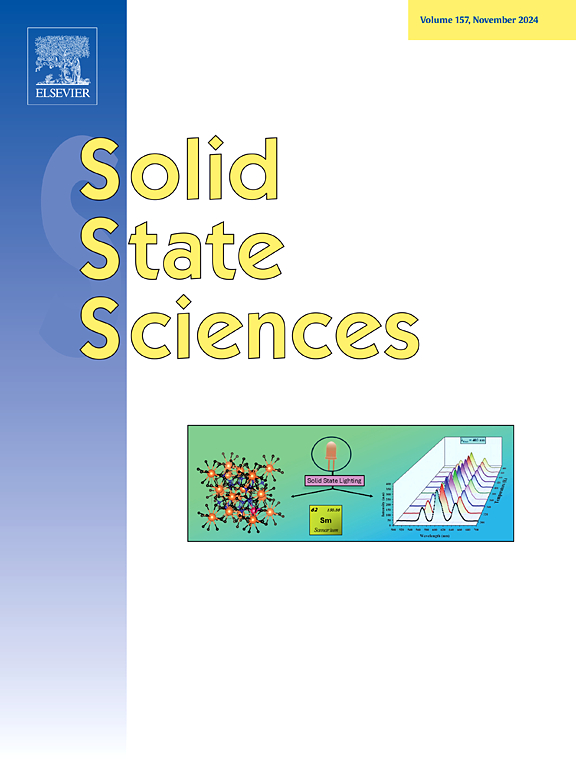提高(Fe, Cr)-ZnO/g-C3N4纳米复合材料对清洁能源电催化水分解的催化性能
IF 3.4
3区 化学
Q2 CHEMISTRY, INORGANIC & NUCLEAR
引用次数: 0
摘要
不可再生能源数量的减少和全球气温的上升引起了严重的担忧。因此,利用金属及其氧化物等材料,电化学水分解成为一种高效、经济的制备氢和氧的方法。除了贵金属之外,碳基材料也被认为能有效地促进这些反应。为了提高效率和优化潜在的应用,已经确定在石墨层中加入金属氧化物可以显著提高HER和OER的活性。在这项研究中,我们介绍了一种新设计的复合电催化剂(Fe, Cr)-ZnO/g-C3N4 ((Fe, Cr)-GZN),该催化剂具有增强的电催化性能。采用(Fe, Cr)-ZnO与g-C3N4共沉淀法合成复合材料。利用重要的表征技术对电催化剂的结构进行了全面分析。采用FTO玻璃作为电沉积催化剂,以促进水分解研究。(Fe, Cr)-GZN复合材料具有优异的电化学水分解性能,其过电位为304 mV, OER的Tafel斜率为89 mV dec−1,电流密度为10 mA cm−2。这一性能优于Cr-GZN和Fe-GZN复合材料,证明了(Fe, Cr)-GZN复合材料作为一种极有效的水分解电催化剂的潜力。本文章由计算机程序翻译,如有差异,请以英文原文为准。

Improved catalytic performance of (Fe, Cr)-ZnO/g-C3N4 nanocomposite towards electrocatalytic water splitting for clean energy
The declining quantity of nonrenewable energy sources and rising in temperatures globally pose serious concerns. Therefore, electrochemical water splitting emerges as a highly efficient and cost-effective method of preparing hydrogen and oxygen, utilizing materials such as metals and their oxides. Beyond precious metals, carbon-based materials have been realized to be efficient in facilitating these reactions. To improve efficiency and optimize potential applications, it has also been established that incorporating metal oxides into the layers of the graphite can significantly improve the activity of HER and OER. In this study, we introduce a newly designed composite electrocatalyst, (Fe, Cr)-ZnO/g-C3N4 ((Fe, Cr)-GZN), which demonstrates enhanced electrocatalytic performance. The composite material was synthesized through the coprecipitation of (Fe, Cr)-ZnO with g-C3N4. The electrocatalyst's structure was fully analyzed using the important characterization techniques. FTO glass was employed to electrodeposit catalysts to facilitate water splitting investigations. The (Fe, Cr)-GZN composite demonstrated excellent electrochemical water splitting performance, with low overpotentials of 304 mV and a Tafel slope of 89 mV dec−1 for OER, resulting in 10 mA cm−2 (current density). This performance outperforms Cr-GZN and Fe-GZN composites, demonstrating the (Fe, Cr)-GZN composite's potential as an extremely efficient electrocatalyst for water splitting.
求助全文
通过发布文献求助,成功后即可免费获取论文全文。
去求助
来源期刊

Solid State Sciences
化学-无机化学与核化学
CiteScore
6.60
自引率
2.90%
发文量
214
审稿时长
27 days
期刊介绍:
Solid State Sciences is the journal for researchers from the broad solid state chemistry and physics community. It publishes key articles on all aspects of solid state synthesis, structure-property relationships, theory and functionalities, in relation with experiments.
Key topics for stand-alone papers and special issues:
-Novel ways of synthesis, inorganic functional materials, including porous and glassy materials, hybrid organic-inorganic compounds and nanomaterials
-Physical properties, emphasizing but not limited to the electrical, magnetical and optical features
-Materials related to information technology and energy and environmental sciences.
The journal publishes feature articles from experts in the field upon invitation.
Solid State Sciences - your gateway to energy-related materials.
 求助内容:
求助内容: 应助结果提醒方式:
应助结果提醒方式:


